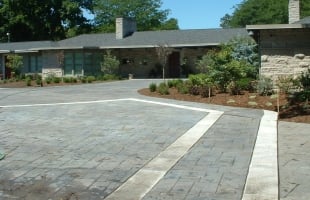 Concrete Driveways are preferred over other paving materials for a variety of reasons:
Concrete Driveways are preferred over other paving materials for a variety of reasons:
Durability is a key to the longevity of driveways. Concrete driveways stand up to traffic day in and day out, year after year, often for over 30 years.
Versatility is important, especially in today's upscale housing market. Concrete can be colored, stamped, or stenciled to create a variety of textures and decorative finishes.
Maintenance free concrete does not need to be seal coated every year.
Environmentally friendly products are becoming more and more important every year. Cured concrete is an inert material and can be recycled.
Homeowner Satisfaction Homeowners were surveyed, and of those already owning a concrete driveway, 96% said they would choose concrete again.
Appearance is a critical component in selecting driveway paving material. Concrete, with it's smooth, bright surface provides an important safety feature by increasing the effectiveness of exterior lighting.
Warranty Programs are available in many parts of the country.
This information used by permission of the National Ready Mixed Concrete Association
Already decided on a concrete drive? Here are some guidelines for installation:
1. Planning and Preparation
- Concrete must be cast on a prepared subgrade that is uniform in soil composition and compaction.
- For drainage, the grade must be sloped a minimum of 1/8th inch per foot from all existing structures
- Stake formwork securely providing a minimum slab depth of 4 inches.
- Dampen the subgrade and formwork prior to placement (particularly during summer construction).
2. Mix Design Recommendations
The mix design recommended for driveway construction must meet the following requirements:
- Compressive strength: 4000 psi minimum @ 28 days (refer to local code requirements)
- Air Content: 6.5 +/- 1.5%
- Aggregates: coarse aggregates meeting MDOT 6AA (ASTM C33, 4S) classification
- Slump: 4 +/- 1 inch
3. Placing and Finishing Guidelines
To construct a durable wearing surface, the sequence for placing and finishing is as follows:
- Screeding or strike-off
- Floating, followed by a waiting period for the water sheen (bleed water) to dissipate
- Edging and jointing
- Brooming (to provide a non-slip surface)
- Do not finish the surface while bleed water is present.
- Do not 'bless" the surface with water to facilitate finishing.
- Do not steel trowel the surface…wood/magnesium floats are recommended.
- Steel trowelling can entrap bleedwater resulting in a non-durable surface
- Discharge from the mixer must be completed within 90 minutes of batching of concrete.
- Prolonged mixing or delayed placement will adversely affect the quality of the concrete with regards to air content and compressive strength.
- Control joints must be spaced at intervals not exceeding 10 feet with a minimum depth of cut equal to ¼ the slab thickness. A centerline control joint is required for driveways greater than 12 feet in width.
- Where new construction abuts existing structures (i.e. garage floors, brick veneer walls, fence posts, etc.) an isolation joint extending the full depth of the concrete slab is required.
4. Curing Requirements
- Following placement, the driveway must be cured to attain the strength and durability potential of the concrete.
- From mid-April to mid-September, cure the concrete incorporating one of the following methods:
- Apply a membrane curing compound according to the manufacturer's instructions.
- 7 day continuous water soaking
- Saturated burlap with polyethylene cover (secured in place)
- From mid-September to mid-April, employ a waterproof cover (i.e. insulating blankets) maintaining the curing temperature above 55°F for a minimum of 7 days.
- Cold weather concreting practices must be observed for concrete placed after November 1st.
5. Homeowner Care
- Do not drive on the 'new' concrete for at least 7 days.
- Do not allow water to drain beneath the slab ….. settlement cracks may develop.
- Do not allow snow and ice to accumulate the first winter ….. keep the driveway shoveled off.
- Do not apply deicing chemicals for snow and ice removal the first winter. As an alternative, sand can be used for traction.
- WARNING: Never use deicers containing ammonium sulfate or ammonium nitrate (i.e. fertilizers). Such products are known to aggressively attack concrete.
- Michigan is classified as a severe weathering region. Therefore, a sealer must be applied approximately 30 days following placement provided that the surface is dry and ambient temperatures are above 55°F.
- Contact your local Ready Mix producer (or building supply store) to purchase a concrete sealer.
- Follow the manufacturer's instructions for sealer application.
- Re-application of the sealer is generally required every 2 years.
![]() Concrete Driveways are preferred over other paving materials for a variety of reasons:
Concrete Driveways are preferred over other paving materials for a variety of reasons: